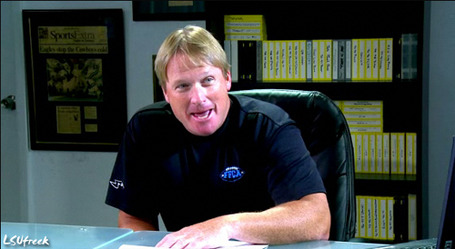This weekend the game of football lost a real gem of a coach in Brad Verdon, who passed away in his sleep this weekend at 44. I had the pleasure of working with and learning from Brad during our seasons together (2002 - 2006). We became very close friends during this time.
If you're a reader of this blog with any regularity, much of the content you've enjoyed was the result of countless late night bar napkin arguments with Brad. I learned a lot of hard lessons from this salty St. Ambrose Graduate Assistant. More important than scheme talk, Brad was passionate about developing relationships with all the kids in the program and constantly checking up on all his players.
Brad was the most understanding and compassionate person I've ever had the pleasure of knowing and was a devoted uncle to his nieces and nephews.
Make the moments you share with the people you're around count. Enjoy this holiday season with your families and staff.
Monday, December 30, 2013
Tuesday, November 26, 2013
Defending Uptempo: Circle The Wagons
>>this is another collaborative post with hemlock<<
PREVIOUS COMMENTARY
Nick's unnerved at the thought of losing control of the game, despite the fact that his system provides as sound of an approach for preparing players for dealing with the realities of spread football as any. He's still saying that the NCAA should do something to slow offenses down because it takes all of the adjustments and special schemes that coaches create out of the game.
PREVIOUS COMMENTARY
Nick's unnerved at the thought of losing control of the game, despite the fact that his system provides as sound of an approach for preparing players for dealing with the realities of spread football as any. He's still saying that the NCAA should do something to slow offenses down because it takes all of the adjustments and special schemes that coaches create out of the game.
Coaches, not just fans are having a hard time dealing with this. Moreover, unlike the wishbone and what not, this is probably not going anywhere. For a number of reasons the uptempo attack s probably here to stay.
Case in point, using this year's Texas A&M and Alabama game, with the assumption that A&M came out with guns firing, giving it their best shot in the first half and the second half pretty much was determined and the game took an entirely different direction. Taking a look at the 36-something offensive snaps (19 1st & 10s) A&M had between the 10s (wiping the goal line scenarios), just to see how Bama was going to play them and what A&M was after.....
3x1 and 3x2 83% of the snaps
pressuring 3x2 45% of the time and 3x1 31%
A great example of this chess match was evidenced in the first series of A&M. A&M starts in 3x2 then motions into the formation, for which a rote response from a Saban defense (automatic against 3x2 motion) would be "Razor - Check 1 Funnel", where the weak safety rolls back to deep hole player and move the backside linebacker inside as the rat. Coach Sumlin used this to setup the counter with Manziel for an explosive gain.
The next week versus Ole Miss, Bama was sitting in Cover 6 to the field (a standard approach a vertical threat). Ole Miss did a good job with tempo, and while we could go deep into the minutiae of these matchups, there were many occasions where it all boiled down to man to man coverage ("play ball") so all the scheming that Bama intended, wasn't going to help. Even though the results were less than expected, it becomes apparent how out of their element the Bama defense can be when forced to into a situation as fast as Ole Miss was presenting. Of course, this speaks to the tactical advantage of uptempo but should support the investment needed in your defensive players to handle formations with cookie-cutter answers. This has to be clear through the depth chart (everyone on the roster), so there's where coaching / teaching comes into play.
By in large, the answer to "how to handle the spread?" would be "don't change anything". The fact that Saban really did not try to conjure up something "special" seems to suggest that they've reached the limit, at least for now, of their defensive thinking. And this has been par for the course not just for Alabama, but also many of today's defenses.....stick to what you are already doing from within the system you've installed.
By in large, the answer to "how to handle the spread?" would be "don't change anything". The fact that Saban really did not try to conjure up something "special" seems to suggest that they've reached the limit, at least for now, of their defensive thinking. And this has been par for the course not just for Alabama, but also many of today's defenses.....stick to what you are already doing from within the system you've installed.
Addressing this new challenge really becomes a discussion on "what is coaching"? Is it getting 11 guys to follow orders or is it something more? By more, I mean teaching the game of football individually and within their player groups so that each can function autonomously, yet in unison.
It is easy to lose focus and concentrate on how well we can rep "34 Lead, damnit!" in practice, ensuring all the kids are following orders, and call that coaching. When we settle for just that, are we really teaching the game and the intent of what we're after? I would think we need to press further so that the players can move beyond just doing what they're told and are able to process the field to defend the ball? When we can get there, when we can distill it down to some adaptable concepts for the players the units should be able to function on their own, and consequently, at a faster pace (both offensively and defensively).
And so we can go back to the "Saban Method"TM and how there is no benefit to re-scheme an opponent when you already have a framework to handle the expanse of the field you're operating in (formation vs field position). You develop athletes to be football players and not just skilled positions.
Another limitations defenses face today (in addition to the reduction in time between snaps) is the ever evolving rule changes to ensure safety (targeting, DPI, personal fouls, etc). Whereas, a viable solution could be to handle vertically-centered offenses with 2 Buc coverage approach, more and more it is near impossible to play with any sense of effectiveness because any hit from a defender that would be set up from playing soft zone would likely result in a first down for the offense. What worked 10 years ago on defense, would have many of these shots being flagged today or are simply not effective because the DB is now pulling up rather than laying the guy out.
Another limitations defenses face today (in addition to the reduction in time between snaps) is the ever evolving rule changes to ensure safety (targeting, DPI, personal fouls, etc). Whereas, a viable solution could be to handle vertically-centered offenses with 2 Buc coverage approach, more and more it is near impossible to play with any sense of effectiveness because any hit from a defender that would be set up from playing soft zone would likely result in a first down for the offense. What worked 10 years ago on defense, would have many of these shots being flagged today or are simply not effective because the DB is now pulling up rather than laying the guy out.
Monday, November 25, 2013
New Metrics For Today's Defenses?
NEWS
FLASH: DEFENSIVE COORDINATORS ADDED TO ENDANGERED SPECIES LIST
Overview and Background:
We are ten weeks into the college
football season and already a highly respected defensive coordinator has been
fired and the nation’s most elite unit had over half a thousand yards hung on
it in one afternoon. It would seem that
offenses today must really be ahead of defenses, a thought that would seem to
suggest that with time, as the offenses did in the good old bad old days,
invariably catch up. But maybe something
else is at work here, something that the powers that be in the game, the Mack
Browns and Nick Sabans of the world, are reluctant to admit, the possibility
that the terrain upon which the game is played has so radically shifted that
the old benchmarks according to which defenses were once measured simply no
longer apply. Put differently, holding
an offense to 300 / game is just not a realistic goal when two teams of similar
talent take the field. With this in
mind, what, then, broadly speaking, should be the goals for defenses in the age
of the spread and how should they go about trying to achieve them in an
increasingly frenetic, hostile, and strained environment?
It would be easy to turn this piece into
something of a eulogy for Manny Diaz and scathing critique of Mack Brown. Readers of this blog know that we respect Coach Diaz and thus, for that matter, by logical extension, know that we view
the situation developing in Austin as being a classic example of the “you reap
the seeds you sow” whirlwind. The fact
of the matter is that against today’s increasingly efficient and streamlined spread
offenses defense as traditionally played, evaluated, schemed, and executed is
no longer feasible. Monte Kiffin
returned to the NFL not just because he wanted to buoy his son on another year, but
because he wanted to coach in a league without Oregon, UCLA, Cal, Arizona
State, and Arizona; little did poor Monte know when he fled for Dallas that
he’d have to face Chip Kelly. Oh, well.
But Texas is not the only place where proud defensive units with excellent personnel are getting ripped up by offenses, sometimes with younger, rawer, and less talented personnel. Yes, Alabama won, and yes they were playing against one of the best offenses in the country, but according to virtually every metric, they played worse in Sunday’s victory than in last year’s defeat. And what about the famed black shirts of Nebraska? For the second year in a row they were scorched by a no-frills spread attack predicated not on trickery and chicanery but straightforward football, which is to say, a lot of inside zone (and a watered down version of that, to say the least), key screens, some verts, a new interpretation of Go Switch, and a nifty little snag game that everybody knows is coming on third down when Coach Mazzone needs to make a money call. Oh, and don’t forget about the new and very young crew slinging their version pure blue sky up there on corners of Berkeley, freshmen and sophomores, mostly, going toe to toe against Northwestern and Ohio State, snapping the ball over 90 times / game and averaging over 500 yards every time out. Clearly the game is up. What used to work is no longer applicable because not simply has the vocabulary of the game changed, but so has its very language.
Objectives:
We will sketch here in broad strokes
what we think the new metric for defense should be. We will then, and again, in broad terms,
review how some teams, such as Alabama and Nebraska, are defending spread teams
this year. Our next step will be to
consider specific keys that defenses need to consider as they prepare every
week. Finally, we will suggest, perhaps
controversially, that they best way to defend the spread today is to regress a
little.
The New Metric:
We believe that there are five basic criteria according to which defenses today, in one form or another, must be measured.
- Negative Yardage Plays: these plays are incredibly disruptive to up-tempo, spread outfits. They derail them, force them into a type of safe mode that makes them slow down.
- Limit Explosives: by this we mean, any play of twenty yards or more. These plays are certain to elicit a NASCAR type response from an up-tempo offense, a response that can be no more complicated than inside zone, but now, with keys and quicks attached to them as automatic parts of the base play.
- 3rd Down: obviously, this draws heavily on the above results, but it must be accounted for. Up-tempo teams are incredibly stripped down outfits that carry a bare minimum number of plays into a game. What they run on 3rd down thus should be painfully evident. Like the Huskers of yesteryear, the Bruins today have a very finite number of things they run on 3rd down.
- What you can live with: This is essentially a supplement to point 3 that deals with the multi-faceted element of every play today. Virtually all teams tag quicks and screens to everything they run. The question is, then, what can you live with getting beat by and what you absolutely cannot tolerate.
- Limit scores / settle for FGs: When Mike Leach was at Texas Tech his defenses under Ruffin McNeil were none as fairly vanilla units, basic match-zone stuff that brought very little heat. This was by design for Leach’s goal was to turn the game into a duel of possessions. Confident that his unit would score touchdowns more often than not the goal on defense was to either minimize the possessions of the opposition or to create more possessions for his own offense through turnovers and stalled drives. In a way, this is what Tommy Spangler tried to do at LaTech, something his units were often successful at when healthy.
Sunday, September 15, 2013
Cal's Solid Screen
The much anticipated match-up of Cal and Ohio State ended as many expected it would. The fledgling Cal Bears in the first season of Sonny Dykes just didn't have the horses to run with a top 5 BCS program, particularly on defense. When freshman quarterback, Jared Goff, was able to get on the field, he was able to display some of the handiwork of the Tony Franklin repertoire from the past 10 years.
One concept in particular, the solid screen, illustrated how tying several concepts together to provide a simple constraint on defenses. The key/flash screens used early in the game coupled with inside zone runs supplied the necessary horizontal stretch to minimize risk and keep the tempo high (even OSU utilized this). Franklin and company have used solid screens for years, which combine both of these concepts into one play to counter pursuit against zone runs.
Lasso 41 Solid
The offensive line aggressively tracks zone for 3 steps to elicit this defensive response, then looks to set up a screen alley by running flat down the line of scrimmage. Closing out the 1st quarter on 3rd and 7, the Buckeyes show soft cover 2 with 6 in the box, but later roll to cover 3 to the field. Franklin used solid to counter his bread-and-butter play from Louisiana Tech, which would have been a rollout to the field, running a high-low with the twin receivers (Lasso 98 Out / 91 Smash). This actually worked well for Cal because the 2 playside linebackers opened to the boundary, allowing the PST and PSG to widen them away from the screen alley. The BSG and BST will release flat and pick up the first trash they see. On this play, the BST becomes what is known as the "rat killer", wiping out any defensive lineman with thoughts of pursuing the play (usually a cut block).
The first half of offense was interesting from Cal, particularly with the repeated use of 68 stick early in the 1st quarter. Up to this game, Cal had been a vertically focused team and not reliant on perimeter plays as much as Louisiana Tech was. The use of 98 Out, 68 Stick, 41/51 flash screens and zone early in the game looked to stretch OSU horizontally with the intention of going back to a downfield homerun throw later. This was attempted a few times, but Cal missed several of these opportunities. The 2nd half presented fewer opportunities for the Cal offense to get started again. Franklin used Zack to counter the first half's zone runs, then standard 2-back counter in the 4th. After a full season in this offense, Cal should be primed to fully grasp the speed and expectations Franklin and company have in mind.
Although pulling for the upset, I was happy to see Tom Herman and Urban Meyer not relent in the 3rd quarter, using their own brand of uptempo to break the Cal defense on several drives.
Monday, July 15, 2013
Tubberville - Cover 2 Pattern Matching
moar
http://brophyfootball.blogspot.com/2011/04/cover-2-db-drills-raheem-morris.html
http://brophyfootball.blogspot.com/2009/11/pattern-read-corner-response.html
http://brophyfootball.blogspot.com/2009/11/pattern-read-linebacker-response.html
http://brophyfootball.blogspot.com/2009/11/pattern-read-safety-response.html
http://brophyfootball.blogspot.com/2009/11/pattern-read-verticals_19.html
http://brophyfootball.blogspot.com/2009/11/pattern-read-sail.html
http://brophyfootball.blogspot.com/2009/11/pattern-read-verticals.html
Monday, July 8, 2013
Tony Dungy on Defensive Back Fundamentals
Another classic from the vault, no longer commercially available.
Enjoy
Wednesday, July 3, 2013
Norm Chow & The Air Raid Cannon
More goodness from the vault!
Norm Chow (circa mid 1990s) breaks down Y Cross and the philosophy behind many of the concepts that were streamlined to become "Air Raid".
Monday, July 1, 2013
3-4 Reduction Defense
Marvin Lewis provides an overview of his brand of the 3-4, then goes deep into coverage solutions within this framework. This is another offering from the vault of coaching videos no longer available commercially. It starts off slow and is a little disjointed, but after about 30 minutes, he gains momentum explaining the application this system.
Wednesday, June 26, 2013
Chuck Amato - FSU Pass Rush
The Jimmy Johnson-era Miami Hurricanes established the even front speed defense that changed the course of defensive football we know today. However, during the 90's the Florida State Seminoles perfected that formula and demonstrated what type of devastation was possible when a program committed to stocking that side of the ball with elite athletes.
The FSU defensive line became a factory of relentless pass rushers who disrupted the run game on their way to sack the quarterback. The man behind that chaos was Chuck Amato. Not only could Amato pimp the hell out of a Starter windbreaker, he also refined the method for attacking passers from the defensive line.
Below is a clinic from these glory years. This is another video from the archives that is no longer available and required piecing together from some vintage footage and unfortunately, bottoms out at around 2 hours.
Chuck Amato FSU Pass Rush from ragin caucasian on Vimeo.
For a great application of this clinic knowledge, enjoy the 1996 ass whooping put on Danny Wuerffel and try not to cringe.
Monday, June 24, 2013
Netflix for Coaches & Baby Saban
Netflix for coaches you say?
A $12 per month service to stream a library of Coaches Choice productions. Seems like a bargain.
Semi-related, here is a film that apparently is no longer available anywhere commercially. A young and slightly annoyed Nick Saban delivering coverage coaching points.
I have 4 separate copies of this DVD and I haven't been able to successfully rip the video for years. This version is pieced together from a few different video clips and consequently cuts off the last 10 minutes or so. The video makes a lot more sense if you follow along in his 2001 LSU Playbook. The tenets of the video are carried through many of his concepts which can be read here: Nick Saban Posts
Friday, June 14, 2013
IN-AT-OUT DRILL
The following drill was stolen after visiting Vince Okruch’s
Western Illinois 3-3 nickel practices as well as from Jeff Walker’s exhaustive
work, “Coaching the 40 Nickel Defense”,
which every coach absolutely needs to own. I find this drill to be the single
most important technique reinforcement tool to develop consistent
linebackers. The drill can be conducted
at varying levels of difficulty and lends itself to training many players in
rapid succession.
The drill represents the run fits for your linebacker group,
broken into 3 distinct reactions; In, At, and Out (represented here in green,
yellow, red).
The IN area is any quick hitting play between the
guards. This is the
responsibility of the middle or stack (inside) linebacker. Plays represented here would be
dive, trap, or wedge.
The AT area is an immediate responsibility of the
bubble (outside) linebacker sandwiched between the guard and inside the tight
end. Iso, zone, and power are common
“At” runs.
The “Out” area is any play which leaves the box (outside the TE)
towards the perimeter, such as toss, sweep,
stretch.
We use this drill from day 1 after teaching stance and
starts. It is best when repped at
a high-tempo, with verbal cues provided, but no stopping of the drill; make intensity the priority and discourage
improper footwork. Don’t try to
over-complicate the drill or trick your linebackers. This should be an easy
exercise to develop confidence in your players. Also, DO NOT use a ball in this
drill, as it will only slow you down and isn’t what you are reinforcing with this
drill.
We introduce the drill using (single) back flow. We don't exclusively read the flow of the backfield players, as linemen keys are essential, but for the sake of indoctrination we develop our linebackers in stages. The natural way to play linebacker is to just chase after backs. The old school way of doing this was to line your linebackers in front of offensive linemen hoping one of them can provide a decent offensive lineman block (down, pull, base, scoop, etc). This could be frustrating, because if your backer didn’t understand the block, he couldn’t progress in his development and damaged his confidence. Whether ingrained at the lower levels or not, use this momentum to build their skillset rather than trying to “break them” of bad habits. We start with a single back, then progress to adding guards with the read. During camp, we actually paint the field for this drill, just like the (Texas vs. OSU) illustration above.
We introduce the drill using (single) back flow. We don't exclusively read the flow of the backfield players, as linemen keys are essential, but for the sake of indoctrination we develop our linebackers in stages. The natural way to play linebacker is to just chase after backs. The old school way of doing this was to line your linebackers in front of offensive linemen hoping one of them can provide a decent offensive lineman block (down, pull, base, scoop, etc). This could be frustrating, because if your backer didn’t understand the block, he couldn’t progress in his development and damaged his confidence. Whether ingrained at the lower levels or not, use this momentum to build their skillset rather than trying to “break them” of bad habits. We start with a single back, then progress to adding guards with the read. During camp, we actually paint the field for this drill, just like the (Texas vs. OSU) illustration above.
To explain this drill, it’s important to first
understand its benefits.
The purpose is to train your linebackers on the proper:
- Tempo
- Footwork
- Movement
- Reads
- Leverage
- Run support fits
For the entire article about how to run this drill and coaching points used, visit http://strongfootballcoach.com/
Wednesday, April 24, 2013
Sunday, April 21, 2013
Team Speed
Duke Track & Field Coach, Shawn Wilbourn, shares some fundamental training techniques to take the athleticism of your team to the next level.
Weather is great, get your team outside!
Weather is great, get your team outside!
Monday, April 15, 2013
Snag & Scat Revisited
Everyone's favorite quick game is broken down in detail by one of the unsung heroes of quick game efficiency, Gunter Brewer.
Wednesday, April 10, 2013
"PUNT TEAM, GET READY!!"
Yeah, what do you think of when you hear that?
Oh crap....we sucked that series on offense, lets play some more defense I guess..
Not quite, if your special teams is up to the task
This is more fleshing out some notes and a previous post on special teams (here and here), but this video breakdown of HOW TO PRACTICE it should help. I've been at places where we did our best to coach up our special teams units and did the lip service of "making them special". By far the best way I've seen it utilized was at a program where we used special teams as warm up pre-practice for everyone. We would work like 5 - 10 minutes of individual, segmented drills (in the video) then finish with 5 minutes of full unit practice. The real benefit comes when you work half-line punt protection and segmented start in kickoff (first 20 yard sprint, 10 yard escapes, 30 yard pursuit / find). With this true specialization comes the need to really coach details because these opportunities can change the course of the game against any opponent in under 2.5 seconds.
Here is video to chew on while we work on other projects.....
Monday, April 8, 2013
Sunday, March 24, 2013
Monday, March 11, 2013
The Complete Guide to Downloading the "All-22" NFL Film
First
let me start by saying I’m extremely humbled to be a contributor to
what I believe to be the best football blog out there. I’ve been reading
this site for some time, so to be able to add to the discussion on this
site is something I’m very excited about. I want to thank Brophy for allowing me to be a part of this great teaching tool for coaches and football enthusiasts alike.
If you’re anything like me, one of the great moments in your lifetime had to be last year when the NFL announced that it would be selling a subscription service to view the ‘All-22’ film used by coaches. I, like many other people, doubted this would ever happen, but I have never been happier to be wrong.
Now, like every other coach in America, you’re probably wondering just how to get your hands on this film, and even more importantly, how to download it to your computer and burn it to DVD and/or cut it up.
I’m going to approach this from a couple of different angles, because I’m sure there are plenty of you who are reading this who may not be working with a high school or college program. Maybe you just enjoy watching football and doing your own research and study of the game. In that case, this post will be perfect for you, because I’m going to show you a lot of low-cost and/or free resources that you can use to make every cut up you could possibly imagine. Ideally, you should be able to make all this happen for between $100-$150, assuming of course that you already have a computer and a reliable internet connection.
On the other side of the coin, if you happen to be in a program with access to breakdown and editing software like Hudl, LRS, DV Sport or even XOS, then you’ve got a lot of potential issues already taken care of for you, and it will be a much easier task to get the film you want and manipulate it however you want.
One final note, some of the details mentioned here may seem elementary to some of you, but my goal was to make this accessible to coaches who may not be the most comfortable with computers. If I was unclear on anything, or need to expound on something, please let me know in the comments.
Part 1 - What You’ll Need
NFL Game Rewind Season Plus
Yes, unfortunately there’s no (Legal) way around getting access to this subscription, unless you just happen to work at NFL Films. The NFL has come down on it drastically, selling a subscription that will give you access to all replays of TV copies of games for the past four seasons, as well as the past two seasons worth of coaches film. As of the writing of this article, the cost is down to $24.99 from its original price of $69.99. The subscription lasts until July 31 of this year, but twenty five bucks for six months of access to coaches film is a bargain if you ask me.
You can buy a subscription here.
Stream Transport
This completely free stream capture software is a program that use all the time. It takes seconds to download and install and is extremely simple to use. We’ll get into the details later, but make sure you have this installed before you try to download anything. For those of you familiar with programs like Replay Media Catcher, this works just as well, and best of all like I said, it’s completely free.
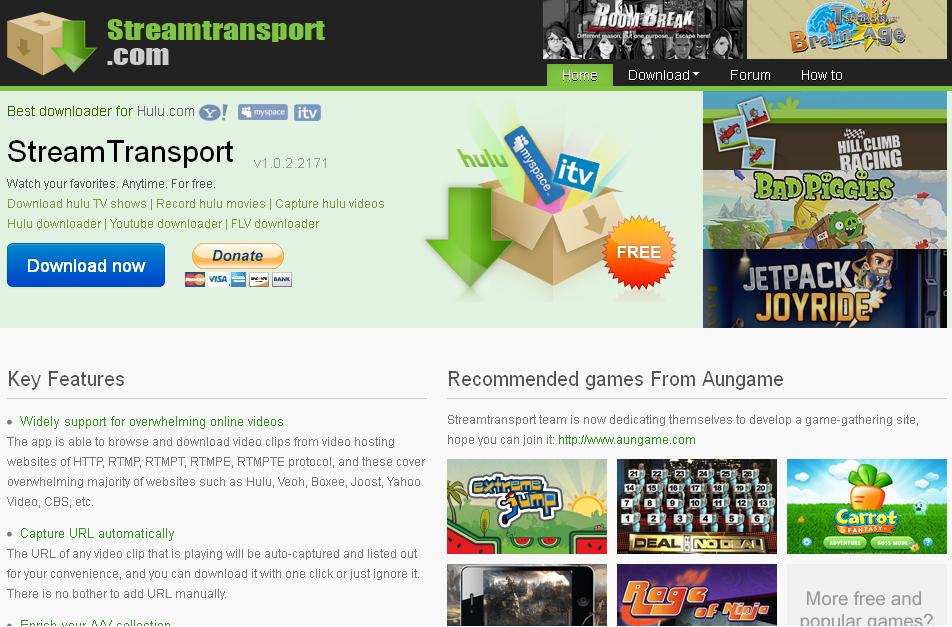
For those of you who like making YouTube videos (Like I do), this program is capable of capturing video from plenty of sites, such as ESPN3.com.
There are a couple caveats to using this program. The first is that it appears to have fallen out of development. In other words, everyone on the internet is constantly updating their minimum requirements for internet browsers, and the makers of Stream Transport don’t seem to have put out an update in over a year. It uses Internet Explorer as its browser, which is bad enough, but when you factor in that it’s a version of Internet Explorer that was phased out over a year ago, it can be a pain. There will be a day in the near future when this program is no longer compatible with most modern websites, and once that happens, people will just have to purchase the aforementioned Replay Media Catcher.
The other downside to this program, and stream capture software in general, is that it works in real time. In other words, if you’re wanting to download a game that’s 90 minutes long, it’s going to take 90 minutes to capture and save it to your computer. I have yet to find a program that doesn’t work in ‘real time’, but if anyone knows of one, please leave a comment below.
The program is available for download here.
Freemake Video Converter
As you probably guessed by the name, Freemake Video Converter is another free software program that I use almost daily. This program is great for burning DVDs, and converting videos from one format to another.
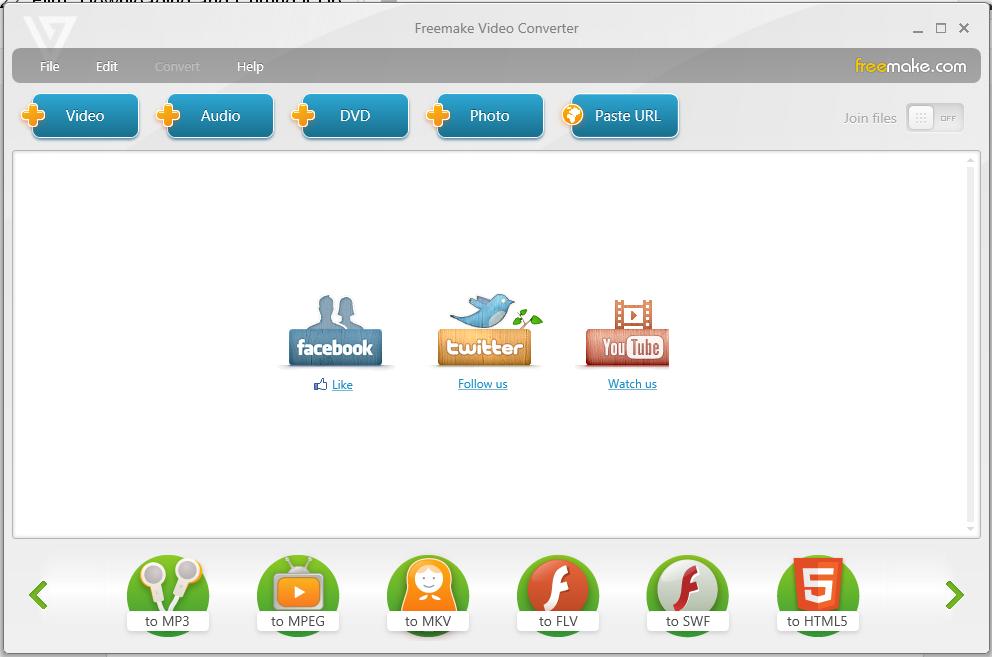
Freemake has a list of all of their downloadable programs, including their video converter, here.RealPlayer

NFL.com encodes all the coaches film in Flash Video format, which is identified by the “.flv” file type. For those of you who download a lot of videos off the internet, this is not news, but there are still plenty of computers without the ability to play these type of videos. Depending on what version of Windows Media Player you’re using, you may not be able to open these files.
I recommend RealPlayer as your go-to video player. It downloads in seconds, it’s easy to install, and best of all it’s free.
(Read through the options carefully during the installation, or you may end up with some free programs you don’t want or need.)
The latest version can be downloaded here.
VideoPad Video Editor
I’ve been using this program for a couple years now, mostly for my own personal projects, and I haven’t found one I like better in the same price range. If you have a video editor that works for you and that you’re comfortable with, then great. What’s important is ease of use and the ability to cut up and convert quickly to whatever video format your system uses.
Also, if your team happens to use Hudl or some other tool you feel comfortable using to cut up and edit film, that will work just as well.
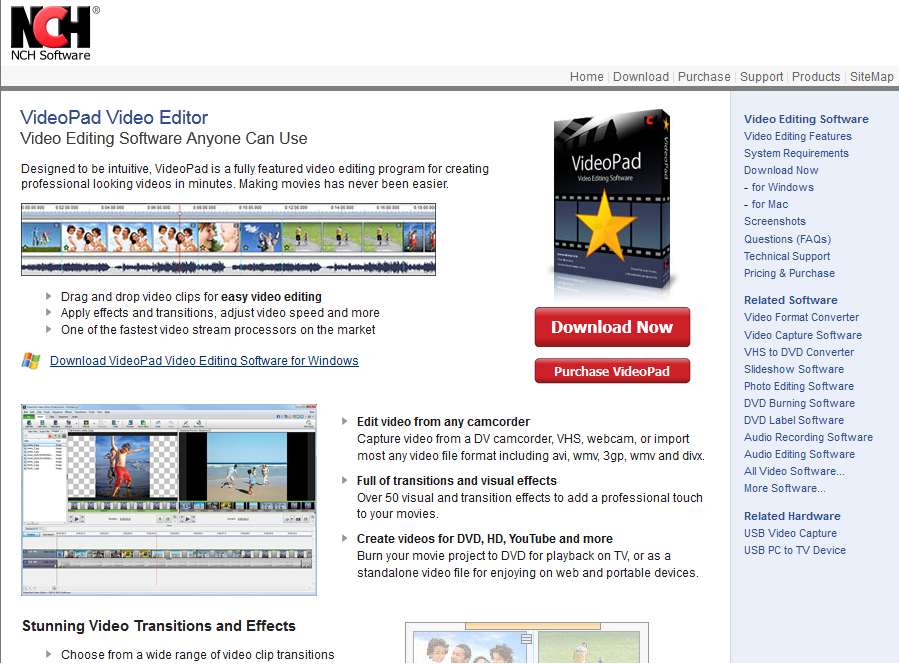
You can download the program here.
External Hard Drive
Depending on how much you’re looking to download and what kind of storage you have on your computer, you may want to look into buying an external hard drive of some kind. Prices vary, but usually a decent 1 Terabyte (1024 GB) hard drive will run you about $100. If you’re serious about putting together a good film library, then it's a very good investment.
Part 2 - The Process
Assuming you’ve already purchased the NFL Game Rewind package with access to the ‘All-22’ film, it’s time to get started.
If you’ve never used Stream Transport before, it may seem confusing at first, but we’ll be covering everything you need to know about the program in this post, so no need to worry.
STREAM TRANSPORT
To begin, open up the ‘Stream Transport’ program, and type in NFL.com into the address bar. It’s important to note that Stream Transport uses Microsoft Internet Explorer as its default browser, the only major fault I can find in the program. (Hopefully the developers switch to something like Firefox or Chrome if they ever decide to put out an upgrade)
Log in to NFL.com with your account, and find the Game Rewind tab, and click ‘Launch’.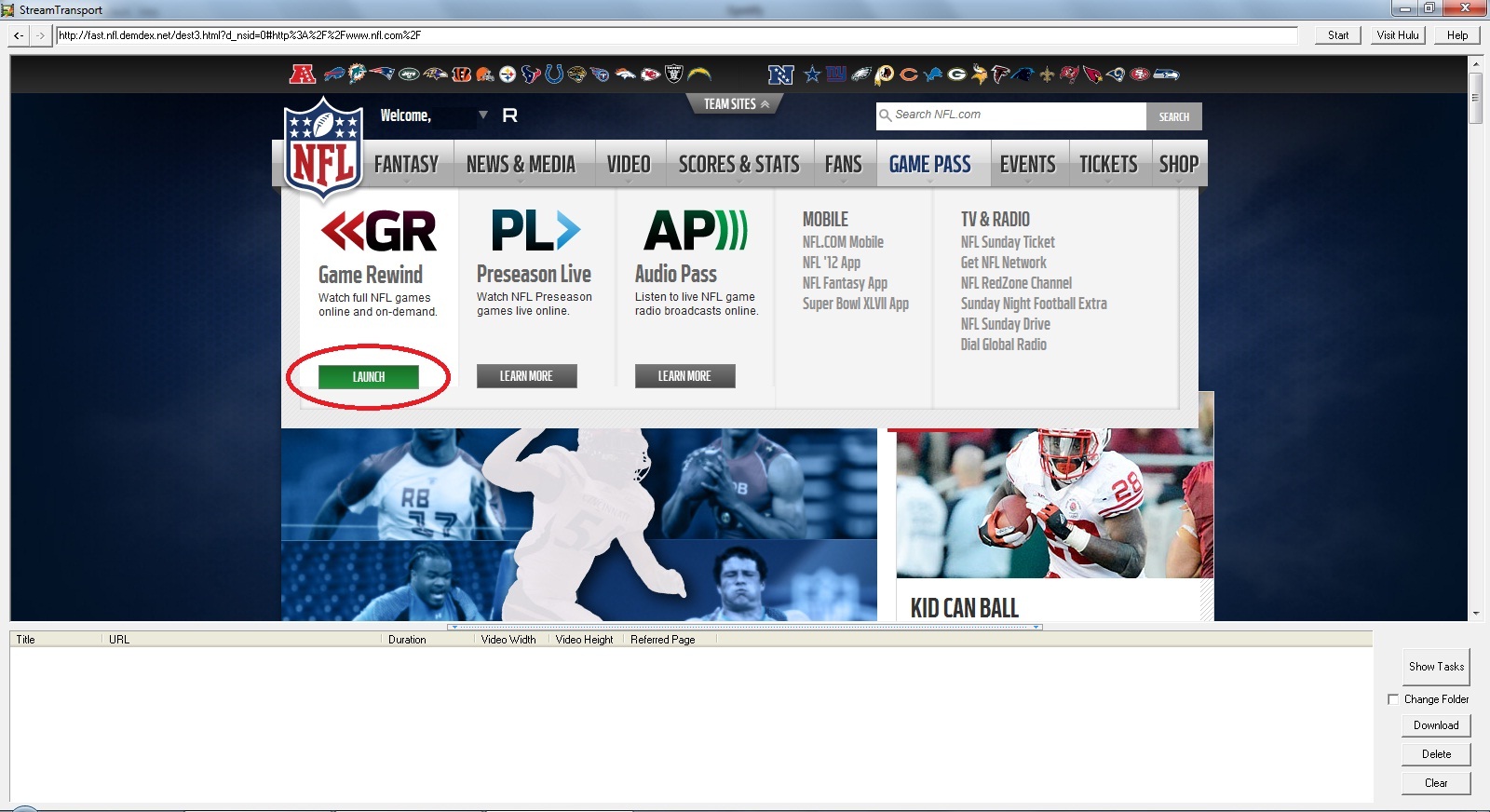
Once you’ve hit the ‘Launch’ button, a screen like the one below should pop up, with the previous week’s games listed. You also have the option to scroll through the past four seasons with the year and week boxes above the ‘Watch’ button. Keep in mind however, that coaches film is only available for the 2012 and 2011 seasons.
Since I’m writing this in the middle of February, the last game played was the Super Bowl, so let’s click on the ‘Watch’ button.
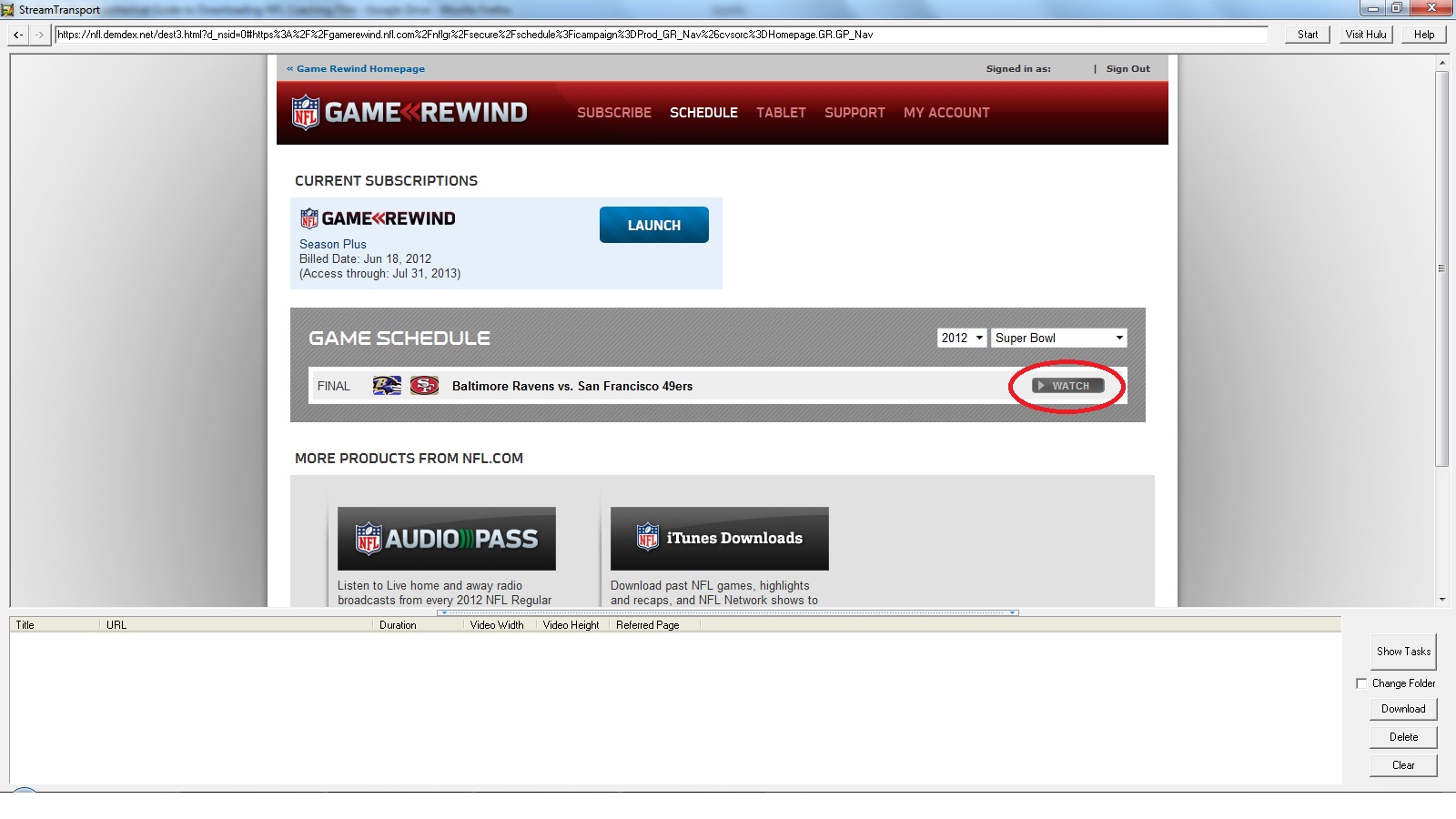
As soon as the game loads up, an edited version of the TV broadcast will start playing, and you’ll begin to notice some stuff start popping up in the bottom box. You should pay attention to the columns labeled ‘Duration’, ‘Video Width’ and ‘Video Height’. As you can see, the duration for all these files that have popped up is zero.
What the NFL has done is sliced up the TV copies of the games into tiny, one second-long clips that would drive Russell Crowe in ‘A Beautiful Mind’ crazy if he tried to sit there and piece them all back together. Luckily, the NFL has decided not to do the same thing with its coaching film, otherwise I’d be sitting on the floor of my office in the fetal position after piecing together a Peyton Manning offensive drive from this past season.

In order to get to the good stuff, move your cursor over the video itself, and there should be three different buttons that pop up, including one that says ‘Coaches Film’. Click on it.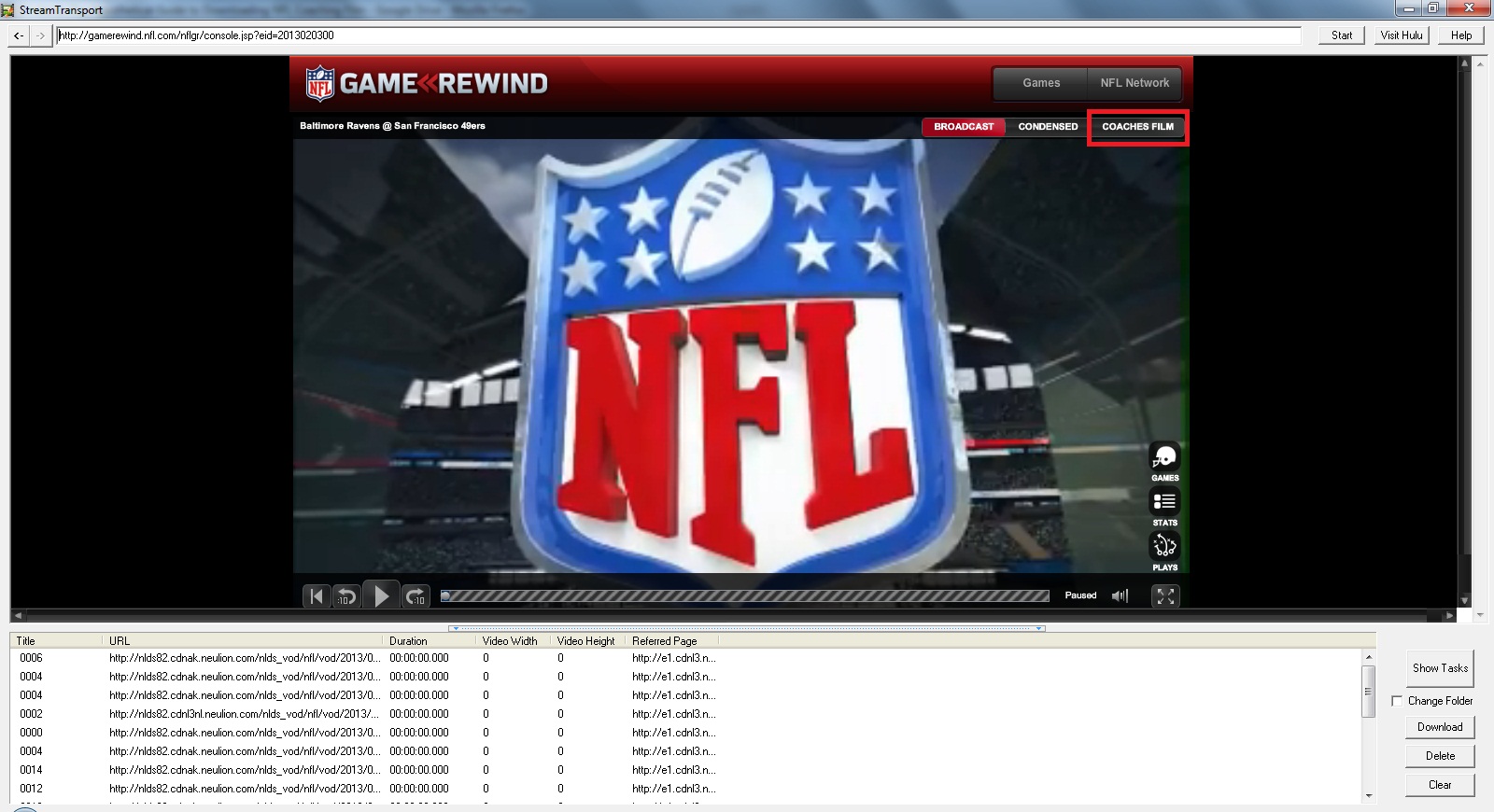
At this point, you should see a scoreboard come on screen, followed by a wide angle shot of a kickoff. NFL.com stores all their coaches film in a ‘Full Game’ format, that means no ‘ODK’ for you college guys. If you want that you’ll have to cut it up yourself. Congratulations, you’ve made it to the promised land, this is what you’ve all been waiting for.
You should also notice in the bottom box that another file has popped up, this time with an actual duration and video height and width. This is the file you want to download. Most downloads average a little over an hour long, but the good news is that they are stored in the compact .flv (Flash Video) format, meaning that 1 hour = approximately 1 GB of storage.
If you’re like me, and want to download as much as possible, you’ll have to get an external hard drive (see my earlier comments on external hard drives).
Once you’ve highlighted the file, check the box labeled ‘Change Folder’, then click ‘Download’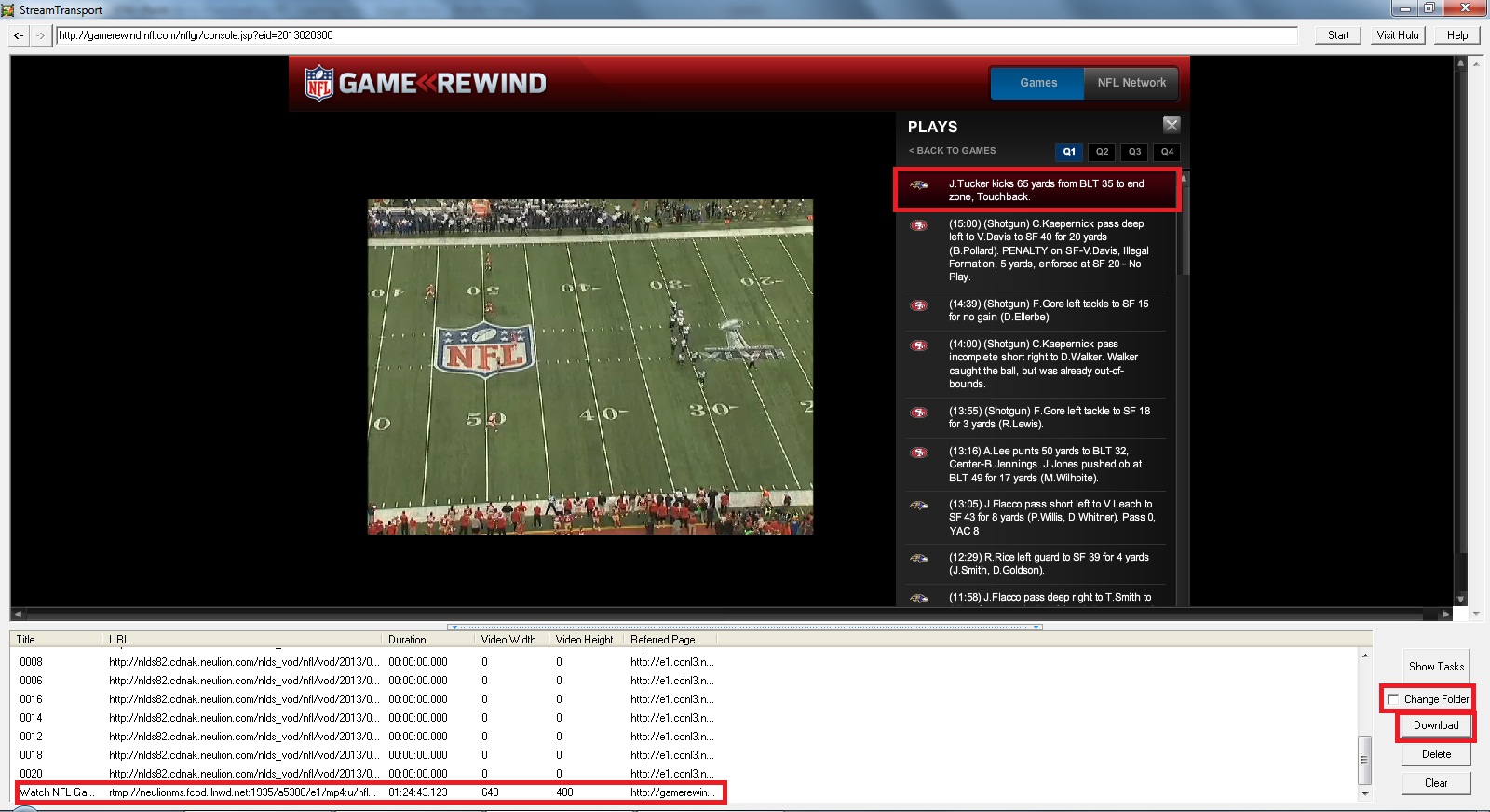
You’ll then have the option to pick where you want to save the videos. I’ve chosen to save them in the “My Videos” folder.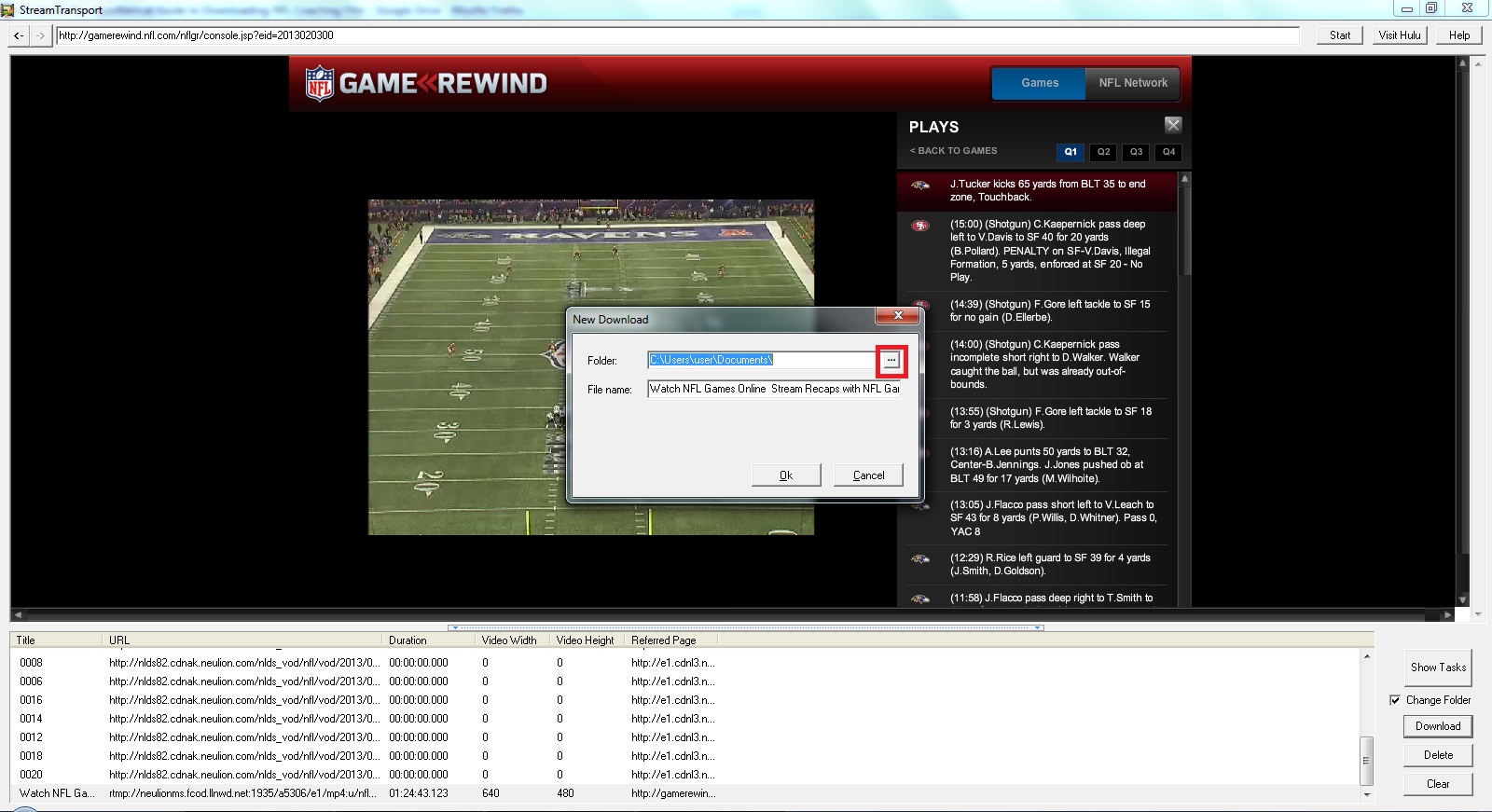
You’ll have your pick of where exactly you want to save it. You can even create a new folder if you want by clicking the “Make New Folder” button.

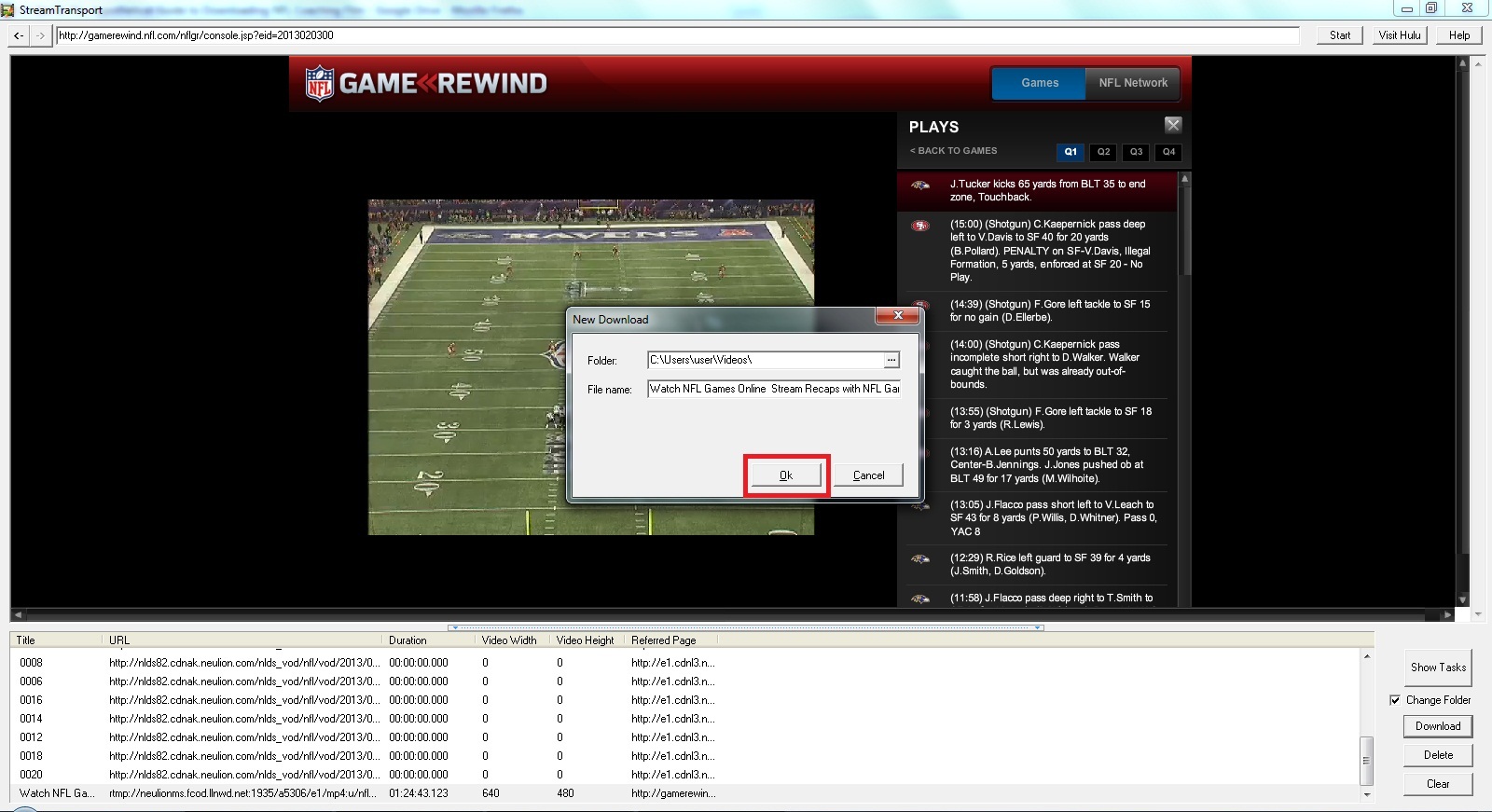
Once you hit the ‘OK’ button, you should see a download box pop up that looks like the one below. It’ll give you a progress report, and you can download up to four videos simultaneously. Once again, you’ll have to download everything in real time, so just minimize the program for about an hour and do something else while it finishes.
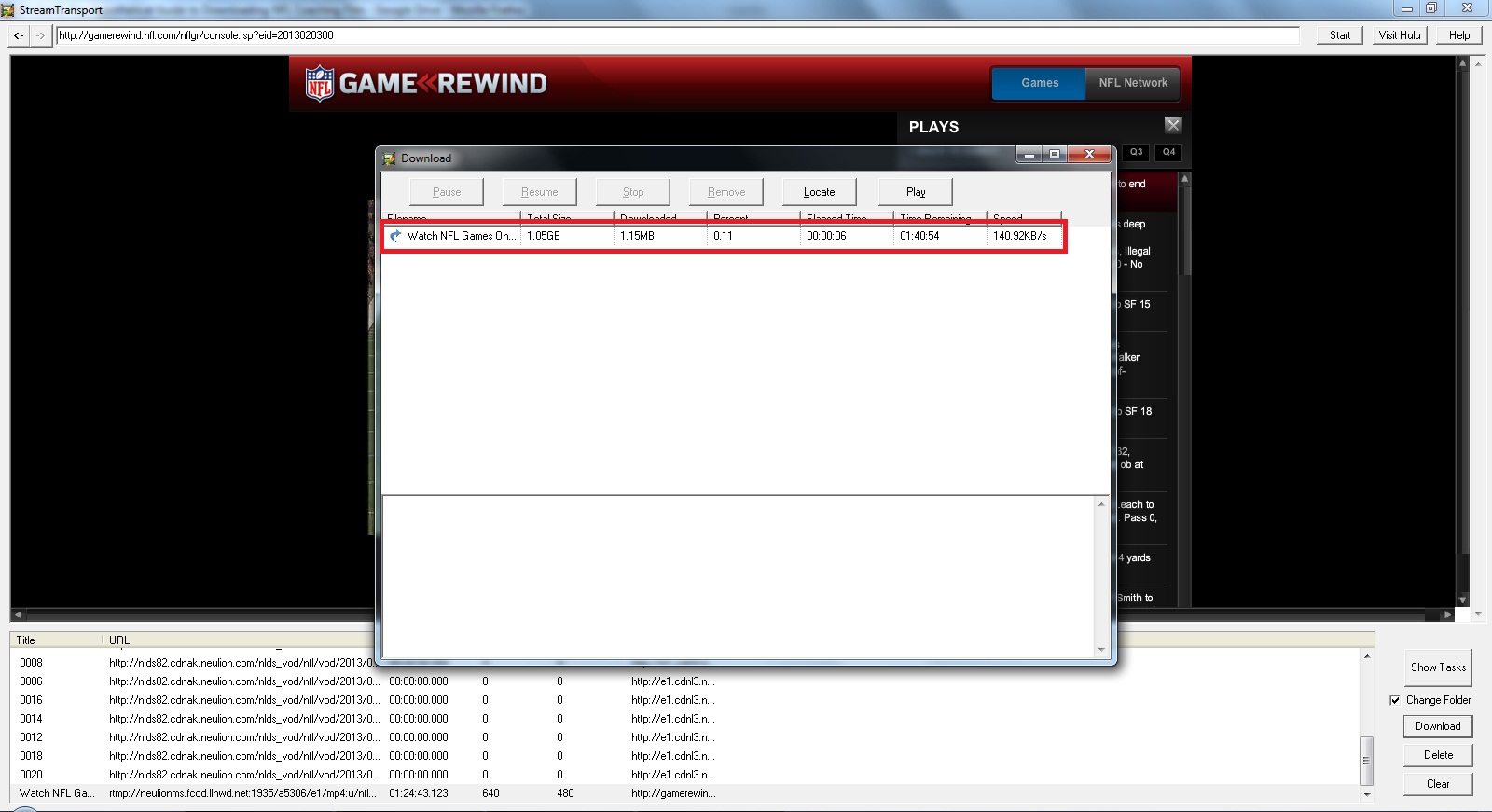
Once the download has finished, you can hit the ‘Play’ button to watch the video.
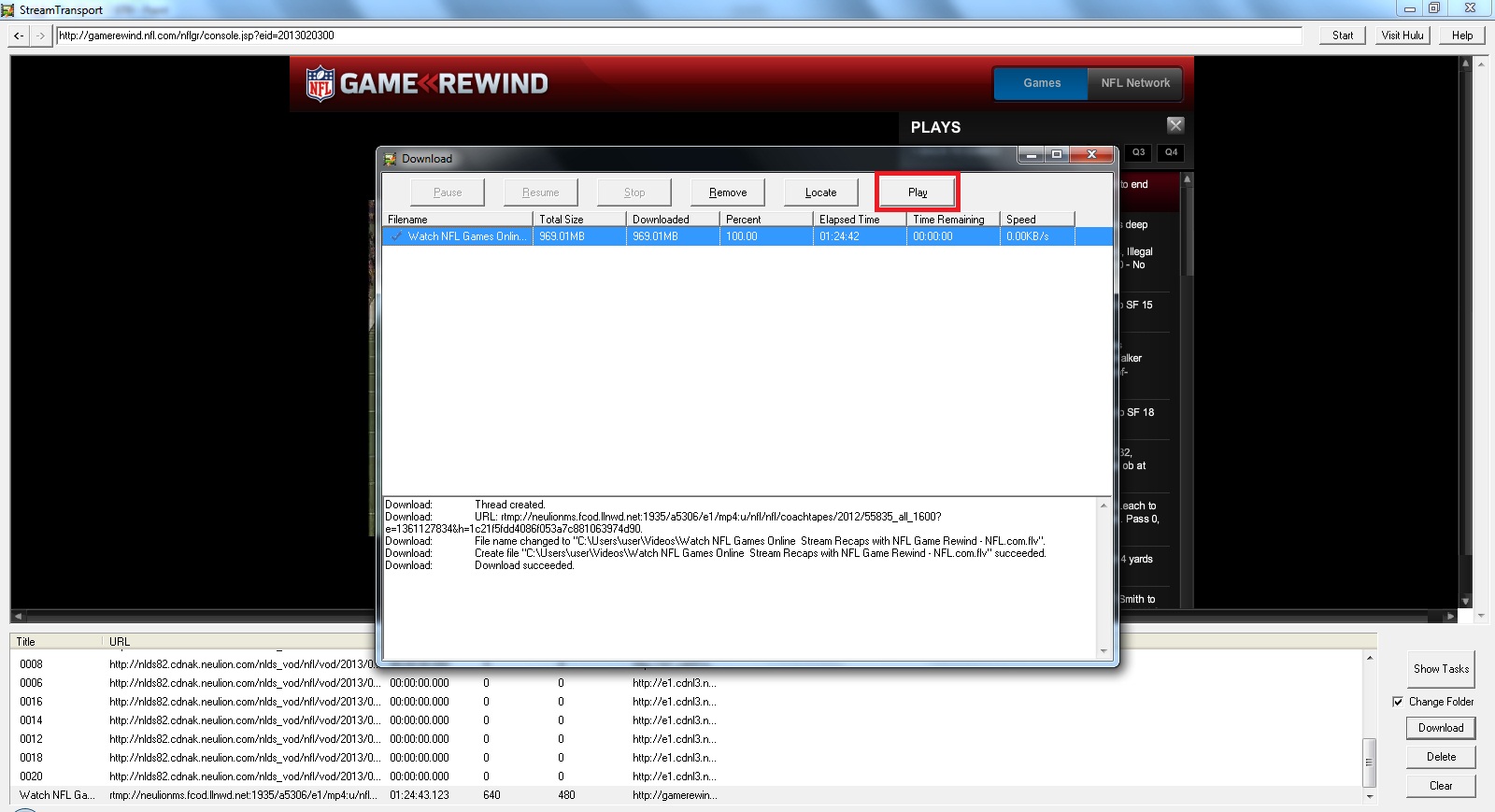
A FEW ASSORTED FINAL THOUGHTS
For best results when burning a DVD, you’ll want to use Freemake Video Converter to convert the .flv files to .mp4 format, since it is the format that most easily converts over to DVD.
Some of you may have the ability to burn directly from whatever film editing program you use, and as long as you can successfully import it into your program, you shouldn’t have much trouble burning it to a DVD.
One thing I must caution you to absolutely NOT do is to post this video on YouTube or any other video site for public consumption. The NFL is one of the most trigger-happy organizations around, and they are constantly patrolling the internet for copyrighted material that has been posted without their permission.
I hope this post has been helpful to you. Please pass it along to your friends in the coaching profession who are interested in getting access to the film. If you have any questions or comments, please leave them below, or feel free to shoot me an email.
Alex Kirby
Video Coordinator
Indiana State University
AKirby7@sycamores.indstate.edu
@AlexJKirby
If you’re anything like me, one of the great moments in your lifetime had to be last year when the NFL announced that it would be selling a subscription service to view the ‘All-22’ film used by coaches. I, like many other people, doubted this would ever happen, but I have never been happier to be wrong.
Now, like every other coach in America, you’re probably wondering just how to get your hands on this film, and even more importantly, how to download it to your computer and burn it to DVD and/or cut it up.
I’m going to approach this from a couple of different angles, because I’m sure there are plenty of you who are reading this who may not be working with a high school or college program. Maybe you just enjoy watching football and doing your own research and study of the game. In that case, this post will be perfect for you, because I’m going to show you a lot of low-cost and/or free resources that you can use to make every cut up you could possibly imagine. Ideally, you should be able to make all this happen for between $100-$150, assuming of course that you already have a computer and a reliable internet connection.
On the other side of the coin, if you happen to be in a program with access to breakdown and editing software like Hudl, LRS, DV Sport or even XOS, then you’ve got a lot of potential issues already taken care of for you, and it will be a much easier task to get the film you want and manipulate it however you want.
One final note, some of the details mentioned here may seem elementary to some of you, but my goal was to make this accessible to coaches who may not be the most comfortable with computers. If I was unclear on anything, or need to expound on something, please let me know in the comments.
Part 1 - What You’ll Need
NFL Game Rewind Season Plus
Yes, unfortunately there’s no (Legal) way around getting access to this subscription, unless you just happen to work at NFL Films. The NFL has come down on it drastically, selling a subscription that will give you access to all replays of TV copies of games for the past four seasons, as well as the past two seasons worth of coaches film. As of the writing of this article, the cost is down to $24.99 from its original price of $69.99. The subscription lasts until July 31 of this year, but twenty five bucks for six months of access to coaches film is a bargain if you ask me.
You can buy a subscription here.
Stream Transport
This completely free stream capture software is a program that use all the time. It takes seconds to download and install and is extremely simple to use. We’ll get into the details later, but make sure you have this installed before you try to download anything. For those of you familiar with programs like Replay Media Catcher, this works just as well, and best of all like I said, it’s completely free.
For those of you who like making YouTube videos (Like I do), this program is capable of capturing video from plenty of sites, such as ESPN3.com.
There are a couple caveats to using this program. The first is that it appears to have fallen out of development. In other words, everyone on the internet is constantly updating their minimum requirements for internet browsers, and the makers of Stream Transport don’t seem to have put out an update in over a year. It uses Internet Explorer as its browser, which is bad enough, but when you factor in that it’s a version of Internet Explorer that was phased out over a year ago, it can be a pain. There will be a day in the near future when this program is no longer compatible with most modern websites, and once that happens, people will just have to purchase the aforementioned Replay Media Catcher.
The other downside to this program, and stream capture software in general, is that it works in real time. In other words, if you’re wanting to download a game that’s 90 minutes long, it’s going to take 90 minutes to capture and save it to your computer. I have yet to find a program that doesn’t work in ‘real time’, but if anyone knows of one, please leave a comment below.
The program is available for download here.
Freemake Video Converter
As you probably guessed by the name, Freemake Video Converter is another free software program that I use almost daily. This program is great for burning DVDs, and converting videos from one format to another.
Freemake has a list of all of their downloadable programs, including their video converter, here.RealPlayer
NFL.com encodes all the coaches film in Flash Video format, which is identified by the “.flv” file type. For those of you who download a lot of videos off the internet, this is not news, but there are still plenty of computers without the ability to play these type of videos. Depending on what version of Windows Media Player you’re using, you may not be able to open these files.
I recommend RealPlayer as your go-to video player. It downloads in seconds, it’s easy to install, and best of all it’s free.
(Read through the options carefully during the installation, or you may end up with some free programs you don’t want or need.)
The latest version can be downloaded here.
VideoPad Video Editor
I’ve been using this program for a couple years now, mostly for my own personal projects, and I haven’t found one I like better in the same price range. If you have a video editor that works for you and that you’re comfortable with, then great. What’s important is ease of use and the ability to cut up and convert quickly to whatever video format your system uses.
Also, if your team happens to use Hudl or some other tool you feel comfortable using to cut up and edit film, that will work just as well.
You can download the program here.
External Hard Drive
Depending on how much you’re looking to download and what kind of storage you have on your computer, you may want to look into buying an external hard drive of some kind. Prices vary, but usually a decent 1 Terabyte (1024 GB) hard drive will run you about $100. If you’re serious about putting together a good film library, then it's a very good investment.
Part 2 - The Process
Assuming you’ve already purchased the NFL Game Rewind package with access to the ‘All-22’ film, it’s time to get started.
If you’ve never used Stream Transport before, it may seem confusing at first, but we’ll be covering everything you need to know about the program in this post, so no need to worry.
STREAM TRANSPORT
To begin, open up the ‘Stream Transport’ program, and type in NFL.com into the address bar. It’s important to note that Stream Transport uses Microsoft Internet Explorer as its default browser, the only major fault I can find in the program. (Hopefully the developers switch to something like Firefox or Chrome if they ever decide to put out an upgrade)
Log in to NFL.com with your account, and find the Game Rewind tab, and click ‘Launch’.
Once you’ve hit the ‘Launch’ button, a screen like the one below should pop up, with the previous week’s games listed. You also have the option to scroll through the past four seasons with the year and week boxes above the ‘Watch’ button. Keep in mind however, that coaches film is only available for the 2012 and 2011 seasons.
Since I’m writing this in the middle of February, the last game played was the Super Bowl, so let’s click on the ‘Watch’ button.
As soon as the game loads up, an edited version of the TV broadcast will start playing, and you’ll begin to notice some stuff start popping up in the bottom box. You should pay attention to the columns labeled ‘Duration’, ‘Video Width’ and ‘Video Height’. As you can see, the duration for all these files that have popped up is zero.
What the NFL has done is sliced up the TV copies of the games into tiny, one second-long clips that would drive Russell Crowe in ‘A Beautiful Mind’ crazy if he tried to sit there and piece them all back together. Luckily, the NFL has decided not to do the same thing with its coaching film, otherwise I’d be sitting on the floor of my office in the fetal position after piecing together a Peyton Manning offensive drive from this past season.
In order to get to the good stuff, move your cursor over the video itself, and there should be three different buttons that pop up, including one that says ‘Coaches Film’. Click on it.
At this point, you should see a scoreboard come on screen, followed by a wide angle shot of a kickoff. NFL.com stores all their coaches film in a ‘Full Game’ format, that means no ‘ODK’ for you college guys. If you want that you’ll have to cut it up yourself. Congratulations, you’ve made it to the promised land, this is what you’ve all been waiting for.
You should also notice in the bottom box that another file has popped up, this time with an actual duration and video height and width. This is the file you want to download. Most downloads average a little over an hour long, but the good news is that they are stored in the compact .flv (Flash Video) format, meaning that 1 hour = approximately 1 GB of storage.
If you’re like me, and want to download as much as possible, you’ll have to get an external hard drive (see my earlier comments on external hard drives).
Once you’ve highlighted the file, check the box labeled ‘Change Folder’, then click ‘Download’
You’ll then have the option to pick where you want to save the videos. I’ve chosen to save them in the “My Videos” folder.
You’ll have your pick of where exactly you want to save it. You can even create a new folder if you want by clicking the “Make New Folder” button.
Once you hit the ‘OK’ button, you should see a download box pop up that looks like the one below. It’ll give you a progress report, and you can download up to four videos simultaneously. Once again, you’ll have to download everything in real time, so just minimize the program for about an hour and do something else while it finishes.
Once the download has finished, you can hit the ‘Play’ button to watch the video.
A FEW ASSORTED FINAL THOUGHTS
For best results when burning a DVD, you’ll want to use Freemake Video Converter to convert the .flv files to .mp4 format, since it is the format that most easily converts over to DVD.
Some of you may have the ability to burn directly from whatever film editing program you use, and as long as you can successfully import it into your program, you shouldn’t have much trouble burning it to a DVD.
One thing I must caution you to absolutely NOT do is to post this video on YouTube or any other video site for public consumption. The NFL is one of the most trigger-happy organizations around, and they are constantly patrolling the internet for copyrighted material that has been posted without their permission.
I hope this post has been helpful to you. Please pass it along to your friends in the coaching profession who are interested in getting access to the film. If you have any questions or comments, please leave them below, or feel free to shoot me an email.
Alex Kirby
Video Coordinator
Indiana State University
AKirby7@sycamores.indstate.edu
@AlexJKirby
Subscribe to:
Posts (Atom)


















